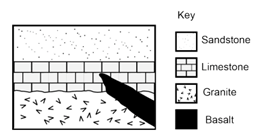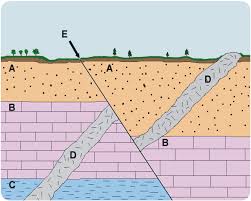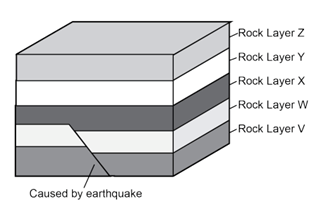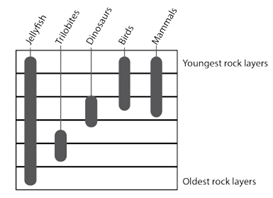Palabras salvajes
Palabras salvajes
Historia útil
This term refers to the study of rock layers. Este término se refiere al estudio de las capas de roca.
What is Stratigraphy? ¿Qué es la estratigrafía?
The earth is THIS many years old. La Tierra tiene ESTOS años.
What is 4.6 billion years? ¿Qué son 4.600 millones de años?
These are the two things that scientists study to learn about the history of Earth. Éstas son las dos cosas que los científicos estudian para aprender sobre la historia de la Tierra.
What are rock strata and the fossil record? ¿Qué son los estratos rocosos y el registro fósil?
An igneous intrusion can tell us THIS about Earth's geological history. Una intrusión ígnea puede decirnos ESTO sobre la historia geológica de la Tierra.
What is volcanic activity? ¿Qué es la actividad volcánica?
This is where you would find the oldest fossils in the fossil record. Aquí es donde encontrarías los fósiles más antiguos del registro fósil.
What is the bottom? ¿Qué es el fondo?
This term refers to the preserved remains of an organism, plant or animal. Este término se refiere a los restos conservados de un organismo, planta o animal.
What is a fossil? ¿Qué es un fósil?
This term refers to the estimated age of a fossil or rock layer in comparison to other layers. Este término se refiere a la edad estimada de un fósil o capa de roca en comparación con otras capas.
What is relative age? ¿Qué es la edad relativa?
These are two things that scientists can learn about the organisms in Earth's geological history by looking at fossils. Éstas son dos cosas que los científicos pueden aprender sobre los organismos en la historia geológica de la Tierra al observar los fósiles.
What are patterns of animal movement and plant life? ¿Cuáles son los patrones de movimiento animal y vida vegetal?
In this picture, WHEN did the basaltic intrusion occur? En esta imagen, ¿CUÁNDO ocurrió la intrusión basáltica?

What is after the limestone layer formed? ¿Qué ocurre después de formarse la capa de piedra caliza?
List the order in which these events occurred, from youngest to oldest. Enumere el orden en que ocurrieron estos eventos, desde el más joven hasta el más antiguo.

What are E, D, A, B, C?
This term refers to the layers of sedimentary rock in Earth. Este término se refiere a las capas de roca sedimentaria de la Tierra.
What is rock strata? ¿Qué son los estratos rocosos?
List the eon, era, period and epoch we currently live in. Enumere el eón, era, período y época en que vivimos actualmente.
What are:
Phanerozoic Eon
Cenozoic Era
Quaternary Period
Holocene Epoch
Finding fossils like clams in a layer of the Earth can tell us THIS about the past. Encontrar fósiles como almejas en una capa de la Tierra puede decirnos ESTO sobre el pasado.
What is presence of water or climate? ¿Qué es la presencia de agua o clima?
When did the earthquake in this picture occur? ¿Cuando ocurrió el terremoto de esta imagen?

When was before Layer X was deposited/After Layer W was deposited. ¿Cuándo fue antes de que se depositara la capa X/después de que se depositara la capa W?
What happened between D and E that caused it to be a flat surface? ¿Qué pasó entre D y E que provocó que fuera una superficie plana?
What is Erosion? ¿Qué es la erosión?
This term refers to the remains of organisms and the layers that those remains are found in. Este término se refiere a los restos de organismos y las capas en las que se encuentran esos restos.
What is the fossil record? ¿Qué es el registro fósil?
WHY are the oldest rock layers found at the bottom? ¿POR QUÉ las capas de roca más antiguas se encuentran en el fondo?
Because newer rocks and minerals pile on top of the older ones, creating visible layers. Porque las rocas y minerales más nuevos se acumulan sobre los más antiguos, creando capas visibles.
Which animals in this chart did NOT live at the same time? ¿Qué animales en este cuadro NO vivieron al mismo tiempo?

Trilobites did not live at the same time as dinosaurs, birds, or mammals. Los trilobites no vivieron al mismo tiempo que los dinosaurios, las aves o los mamíferos.
A magma intrusion comes from this part of the Earth. Una intrusión de magma proviene de esta parte de la Tierra.
What the inside or center of the Earth? ¿Qué es el interior o centro de la Tierra?
How can we determine the approximate age of Earth? ¿Cómo podemos determinar la edad aproximada de la Tierra?
What are using the Law of Superposition when looking at rock layers (strata) and the index fossil record and comparing the data?
¿Por qué se utiliza la Ley de Superposición cuando se observan capas de roca (estratos) y el registro fósil índice y se comparan los datos?
This term refers to the timing and relationship of events that occurred throughout the history of Earth.
Este término se refiere al tiempo y la relación de los eventos que ocurrieron a lo largo de la historia de la Tierra.
What is the Geologic Time Scale? ¿Qué es la escala de tiempo geológico?
Correlating (matching and organizing) rock layers with the fossils is useful to geologists for this reason. Correlacionar (emparejar y organizar) las capas de roca con los fósiles es útil para los geólogos por este motivo.
Answers may vary:
What is helping to find Index fossils, which represent organisms that were only around for a relatively short period of time, so where a fossil is found helps to determine the age of the rock. It helps geologists determine the relative ages of the rocks and sequence the events that formed Earth’s history.
Las respuestas pueden variar:
¿Qué ayuda a encontrar fósiles índice? Estos representan organismos que existieron durante un período relativamente corto. Por lo tanto, el lugar donde se encuentra un fósil ayuda a determinar la edad de la roca. Ayuda a los geólogos a determinar las edades relativas de las rocas y a secuenciar los eventos que dieron forma a la historia de la Tierra.
What are index fossils? ¿Qué son los fósiles índice?
Fossils that were widespread/abundant and only appear in a short period of time. Fósiles que estaban muy extendidos/abundantes y sólo aparecen en un corto período de tiempo.
The Redwall Limestone layer from the Colorado River has these fossils found in it. Se encontraron estos fósiles en la capa de piedra caliza Redwall del río Colorado.
What are brachiopods, clams, snails, corals, fish, and trilobites? ¿Qué son los braquiópodos, las almejas, los caracoles, los corales, los peces y los trilobites?
Describe the order of events from youngest to oldest. Describe el orden de los acontecimientos desde el más joven al más viejo.
What are B, D, F, A, G, E, H, C?